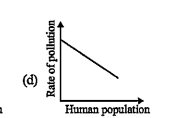Which of the following position-time graphs correctly represents two moving objects A and B with zero relative velocity ?




The correct Answer is:A
To determine which position-time graph correctly represents two moving objects A and B with zero relative velocity, we need to analyze the slopes of the graphs. Here’s a step-by-step solution:
Step 1: Understand the Concept of Relative Velocity
Relative velocity is defined as the velocity of one object as observed from another object. If two objects have zero relative velocity, it means they are moving at the same velocity.
Step 2: Analyze the Position-Time Graphs
We are provided with four position-time graphs. We need to evaluate the slopes of these graphs:
- The slope of a position-time graph indicates the velocity of the object.
- If two objects have the same slope, they have the same velocity.
Step 3: Examine Each Graph
1. Graph 1: Check if the slopes of lines representing objects A and B are equal.
- If both slopes are equal, then the velocities are equal, indicating zero relative velocity.
2. Graph 2: Check the slopes of A and B.
- If the slopes are different, then the velocities are not equal, indicating non-zero relative velocity.
3. Graph 3: Repeat the slope check for A and B.
- Again, if the slopes differ, the relative velocity is not zero.
4. Graph 4: Check the slopes of A and B.
- If the slopes are different, the relative velocity is not zero.
Step 4: Conclusion
After analyzing all four graphs:
- If Graph 1 shows equal slopes for both A and B, then this graph represents zero relative velocity.
- The other graphs (2, 3, and 4) show different slopes, indicating non-zero relative velocities.
Thus, the correct answer is Graph 1.
Relative velocity is defined as the velocity of one object as observed from another object. If two objects have zero relative velocity, it means they are moving at the same velocity.
We are provided with four position-time graphs. We need to evaluate the slopes of these graphs:
- The slope of a position-time graph indicates the velocity of the object.
- If two objects have the same slope, they have the same velocity.
1. Graph 1: Check if the slopes of lines representing objects A and B are equal.
- If both slopes are equal, then the velocities are equal, indicating zero relative velocity.
2. Graph 2: Check the slopes of A and B.
- If the slopes are different, then the velocities are not equal, indicating non-zero relative velocity.
3. Graph 3: Repeat the slope check for A and B.
- Again, if the slopes differ, the relative velocity is not zero.
4. Graph 4: Check the slopes of A and B.
- If the slopes are different, the relative velocity is not zero.
After analyzing all four graphs:
- If Graph 1 shows equal slopes for both A and B, then this graph represents zero relative velocity.
- The other graphs (2, 3, and 4) show different slopes, indicating non-zero relative velocities.
Topper's Solved these Questions
- MOTION IN STRAIGHT LINEBOOK - AAKASH INSTITUTECHAPTER - MOTION IN STRAIGHT LINEEXERCISE - Assignment (SECTION - B)
19 Videos
- MOTION IN STRAIGHT LINEBOOK - AAKASH INSTITUTECHAPTER - MOTION IN STRAIGHT LINEEXERCISE - Assignment (SECTION - C)
7 Videos
- MOTION IN STRAIGHT LINEBOOK - AAKASH INSTITUTECHAPTER - MOTION IN STRAIGHT LINEEXERCISE - Try Yourself
40 Videos
- MOTION IN A STRAIGHT LINEBOOK - AAKASH INSTITUTECHAPTER - MOTION IN A STRAIGHT LINEEXERCISE - ASSIGNMENT (SECTION - D)
15 Videos
- MOVING CHARGE AND MAGNESIUMBOOK - AAKASH INSTITUTECHAPTER - MOVING CHARGE AND MAGNESIUMEXERCISE - SECTION D
16 Videos
Similar Questions
Knowledge Check
Which of the following velocity-time graphs (v−tgraph) represent uniform motion
A B
B C
C D
D
Which one of the following represents displacement-time graph of two objects A and B moving with zero relative velocity?
A B
B C
C D
D
Which of the following graph is correctly represented?
A B
B C
C D
D
Which of the following velocity-time graphs does not represent motion in one dimension?
View SolutionWhich of the following figures represents uniform motion of a moving object correctly ?
View SolutionA body nis thrown vertically upward. Which of the following graphs correctly/represents the velocity of the body with time?
View SolutionThe velocity -displacement graph of a particle is as shown in the figure. Which of the following graphs correctly represents the variation of acceleration with displacement?

View SolutionWhich of the following are true ? A body having constant speed can have varying velocity.Which of the following are true? Position time graphs for two objects with zero relative velocity are parallel.Which of the following are true ? The numerical ratio of velocity to speed of an object can never be more than one.
View Solution
